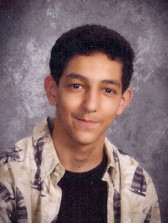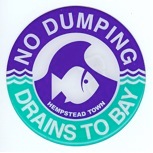West Hempstead teen works to save waterways
West Hempstead High School junior Steven Trezza is a Boy Scout with Troop 240 of West Hempstead. In his pursuit of the rank of Eagle Scout, Steven launched a community service project last year aimed at protecting local waterways through the use of education and awareness.
Calling attention to the need for such protection was the first step of Steven’s West Hempstead Storm Drain Project. To that end, Steven helped place more than 800 “No Dumping” medallions on storm drains throughout the town.
Then, through a series of articles published in the Herald, Steven explained to the community what the medallions mean and why they are there. The Herald is happy to support Steven as he continues his work to protect our local waterways, and encourages residents to join him on May 25 at West Hempstead High School for a workshop with a representative of Operation SPLASH.
By Steven Trezza
In a May 2011 Discover Magazine article titled “There’s Something In The Water,” author Kathleen McAuliffe reported that scientists have found evidence of a possible link between toxins released by blooms of cyanobacteria (blue-green algae) and neurological disorders like Alzheimer’s and Parkinson’s disease.
Researchers found a statistically high number of patients with a neurological disorder living around Mascoma Lake in New Hampshire — an area containing large amounts of cyanobacteria in the soil and water. According to McAuliffe, scientists discovered that algae produce a toxin called beta-methylamino-L-alanine, or BMAA. Experiments have demonstrated that BMAA can kill motor cells in the spinal cord and BMAA resembles a chemical that is known to cause paralyzing disease.
Blooms of algae occur here on Long Island and are caused in part by pollution carried by storm water runoff. Although the research mentioned is inconclusive, there can be no doubt that algae blooms and pollution in any form is not a good thing.
Storm runoff pollution contributes to the formation of brown tides (blooms of algae) in the Great South Bay. In 1976, before the era of brown tides, 700,000 bushels of clams were harvested from the bay. Since then, repeated episodes of brown tides has caused the collapse of the shellfish industry. Last year the harvest on Long Island was 2,000 bushels. If algae blooms can hurt clams, is it possible they can release toxins that hurt people? Wouldn’t it be better to just get rid of the algae and not worry about it?
Have you seen the “No Dumping – Drains to Bay” medallion on the storm drains in West Hempstead? The medallions remind people that only rain belongs in a storm drain. Storm drains empty directly into our local bays. Trash and chemicals that enter our storm drains are also deposited into our local waterways. Pollution carried by storm runoff has a negative impact on water quality. It contributes to brown tides and is part of the reason there is a 180-square-mile dead zone (area without enough oxygen to support life) in the Great South Bay.
The “No Dumping” medallions tell the whole story: no dumping. Do not put anything into a storm drain except rain. Even if you like the color brown and hate oxygen you probably wouldn’t like neurological disorders. By keeping storm water runoff free from pollution you are helping the environment, possibly preventing diseases and making the bay healthier for people and the wildlife and fish that depend on the bay for survival.
Here are some tips to help to keep our lakes, rivers and bays clean:
- Sweep: Don’t use water to clean the sidewalks and driveways. Using water to clean surfaces pushes dirt and pollutants into the storm drain. By sweeping and putting leaves/ debris in the compost or trash we can limit the amount of pollutants flowing into the bay.
- Scoop the poop: Animal wastes contain harmful bacteria. These pollutants can cause infection or disease in humans, animals, and plant life in our waterways. In addition, as organic matter in pet waste breaks down it depletes oxygen in the water.
- Gardening: Cut down on the use of pesticides and fertilizer. Pesticides are poisonous to insects and fish, birds, animals and other living things. Algae respond to fertilizer the same way plants do — they grow. Apply only when needed and in recommended amounts. If you use fertilizer before it rains, much of it will wash into the storm drains, promoting algae growth and cause problems for marine life.
- Pool Care: Do not drain pool chemicals into storm drains. Let pool water sit for a few days and let the sun burn off the chlorine and other chemicals before emptying the water.
- Auto Care: Washing your car at home can send detergents and other contaminants into the storm drains. Use soap sparingly; empty your bucket of used soapy water down the sink, not in the street. Better yet, take your car to a commercial car wash. Most car washes reuse wash water. Please, don’t dump automotive fluids near the curb or drain and check your car for leaks. Recycle used motor oil.
- Household Waste: Do not dispose of hazardous waste in storm drains, sinks or toilets. Dispose of batteries, oil, antifreeze, paint and other household chemicals at the S.T.O.P. Program. Call (516) 378-2200 for dates and location. Use Green Cleaners or non-toxic homemade remedies like baking soda and vinegar.
- Report clogged storm drains: When street sweepers are scheduled to sweep your block make sure no cars are blocking the storm drains so they can be cleaned. If too much trash or leaves accumulate around a drain, the drain can clog, causing our streets to flood. If you see a clogged storm drain report it to the Town of Hempstead Highway Department at (516) 489-5000.
- Missing Storm Drain Medallions: Email Stormdrainproject@hotmail.com with the location of the missing marker.
Want more information on how you can make a difference? Stop by the West Hempstead Lions Club meeting on Wednesday, May 25, at 7:30 p.m. in the West Hempstead High School cafeteria and meet a special guest from Operation SPLASH who will speak about keeping our waterways clean.

 39.0°,
Fair
39.0°,
Fair 







